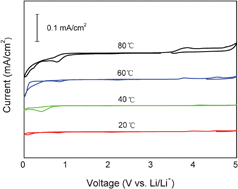Hard carbon: a promising lithium-ion battery anode for high temperature applications with ionic electrolyte
Abstract
Electrochemical behavior of a hard carbon plate in an electrolyte based on a room temperature

* Corresponding authors
a
School of Energy, Soochow University, Suzhou, Jiangsu, P. R. China
E-mail:
hhzheng66@yahoo.com.cn
b Lawrence Berkeley National Laboratory, 1 Cyclotron Rd, Berkeley, CA 94720, USA
Electrochemical behavior of a hard carbon plate in an electrolyte based on a room temperature

 Please wait while we load your content...
Something went wrong. Try again?
Please wait while we load your content...
Something went wrong. Try again?
H. Zheng, Q. Qu, L. Zhang, G. Liu and V. S. Battaglia, RSC Adv., 2012, 2, 4904 DOI: 10.1039/C2RA20536J
To request permission to reproduce material from this article, please go to the Copyright Clearance Center request page.
If you are an author contributing to an RSC publication, you do not need to request permission provided correct acknowledgement is given.
If you are the author of this article, you do not need to request permission to reproduce figures and diagrams provided correct acknowledgement is given. If you want to reproduce the whole article in a third-party publication (excluding your thesis/dissertation for which permission is not required) please go to the Copyright Clearance Center request page.
Read more about how to correctly acknowledge RSC content.
 Fetching data from CrossRef.
Fetching data from CrossRef.
This may take some time to load.
Loading related content
